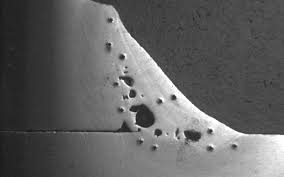Comprehensive Overview: What is Porosity in Welding and How to avoid It
Comprehensive Overview: What is Porosity in Welding and How to avoid It
Blog Article
Deciphering the Secret of Porosity in Welding: Tips for Minimizing Defects and Making Best Use Of Quality
In the intricate world of welding, porosity remains a persistent obstacle that can dramatically impact the top quality and stability of welded joints. Understanding the factors that add to porosity development is essential in the search of flawless welds. By deciphering the mystery of porosity and implementing effective strategies for defect minimization, welders can raise the standards of their work to attain premium quality end results. As we explore the midsts of porosity in welding, revealing the keys to its prevention and control will be extremely important for experts seeking to grasp the art of top quality weldments.
Understanding Porosity in Welding
Porosity in welding, an usual concern experienced by welders, describes the existence of gas pockets or spaces in the welded product, which can endanger the stability and high quality of the weld. These gas pockets are typically caught throughout the welding procedure due to numerous factors such as incorrect protecting gas, infected base materials, or wrong welding specifications. The formation of porosity can damage the weld, making it prone to splitting and rust, inevitably leading to architectural failings.
Comprehending the root causes of porosity is essential for welders to efficiently avoid its event. By identifying the relevance of keeping correct gas shielding, guaranteeing the cleanliness of base materials, and optimizing welding setups, welders can considerably lower the likelihood of porosity formation. Furthermore, making use of techniques like preheating the base product, employing proper welding techniques, and performing comprehensive inspections post-welding can better assist in minimizing porosity problems. In general, a detailed understanding of porosity in welding is necessary for welders to generate high-grade and long lasting welds.

Typical Root Causes Of Porosity
When checking welding procedures for potential high quality issues, comprehending the usual root causes of porosity is important for maintaining weld integrity and avoiding architectural failures. Porosity, defined by the presence of tooth cavities or spaces in the weld steel, can dramatically jeopardize the mechanical homes of a bonded joint. One typical source of porosity is incorrect shielding gas insurance coverage. Inadequate shielding gas circulation prices or inappropriate gas blends can bring about atmospheric contamination, resulting in porosity formation.
Additionally, welding at improper parameters, such as excessively high traveling rates or currents, can generate extreme turbulence in the weld swimming pool, capturing gases and creating porosity. By attending to these common causes via appropriate gas protecting, material prep work, and adherence to optimum welding parameters, welders can lessen porosity and enhance the high quality of their welds.
Strategies for Porosity Prevention
Applying reliable precautionary actions is important in lessening the incident of porosity in welding processes. One method for porosity avoidance is guaranteeing proper cleansing of the base metal prior to welding. Impurities such as oil, grease, rust, and paint can cause porosity, so extensive cleaning utilizing ideal solvents or mechanical techniques is crucial.

Another trick page safety net is the choice of the ideal welding consumables. Making use of high-quality filler products and securing gases that appropriate for the base steel and welding process can substantially reduce the danger of porosity. In addition, keeping proper welding parameters, such as voltage, existing, take a trip rate, and gas circulation rate, is essential for porosity avoidance. Deviating from the recommended settings can cause inappropriate gas insurance coverage and inadequate blend, resulting in porosity.
Moreover, employing appropriate welding methods, such as preserving a regular traveling rate, electrode angle, and arc length, can help stop porosity (What is Porosity). Sufficient training of welders to guarantee they follow ideal practices and high quality control procedures is likewise essential in reducing porosity defects in welding

Ideal Practices for Quality Welds
Making certain adherence to market criteria and proper weld joint preparation are essential facets of accomplishing continually premium welds. In addition to these fundamental actions, there are several best methods that welders can implement to further boost the quality of their welds. One secret technique is maintaining appropriate sanitation in the welding area. Pollutants such as oil, grease, view rust, and paint can detrimentally affect the quality of the weld, resulting in issues. Completely cleaning the workpiece and bordering location before welding can help alleviate these problems.
One more finest technique is to meticulously select the appropriate welding specifications for the specific materials being joined. This includes setting the appropriate voltage, existing, travel speed, and protecting gas circulation rate. Appropriate specification selection makes sure optimum weld infiltration, fusion, and total high quality. In addition, using high-quality welding consumables, such as electrodes and filler steels, can significantly influence the last weld quality. Buying costs consumables can cause stronger, much more long lasting welds with less defects. By complying with these finest practices, welders can regularly generate premium welds that fulfill industry requirements and exceed customer expectations.
Value of Porosity Control
Porosity control plays an important role in visit our website ensuring the integrity and quality of welding joints. Porosity, characterized by the existence of dental caries or voids within the weld metal, can considerably endanger the mechanical residential or commercial properties and structural honesty of the weld. Excessive porosity damages the weld, making it a lot more at risk to breaking, corrosion, and overall failure under operational loads.
Effective porosity control is vital for maintaining the desired mechanical buildings, such as strength, ductility, and sturdiness, of the bonded joint. What is Porosity. By minimizing porosity, welders can enhance the general high quality and reliability of the weld, making certain that it meets the efficiency demands of the designated application
Furthermore, porosity control is vital for attaining the preferred visual appearance of the weld. Too much porosity not only deteriorates the weld however also interferes with its visual charm, which can be critical in sectors where looks are very important. Correct porosity control strategies, such as making use of the right securing gas, regulating the welding specifications, and guaranteeing proper tidiness of the base materials, are crucial for producing top notch welds with very little problems.

Conclusion
In conclusion, porosity in welding is a common issue that can compromise the top quality of the weld. It is essential to regulate porosity in welding to ensure the integrity and stamina of the last product.
Report this page